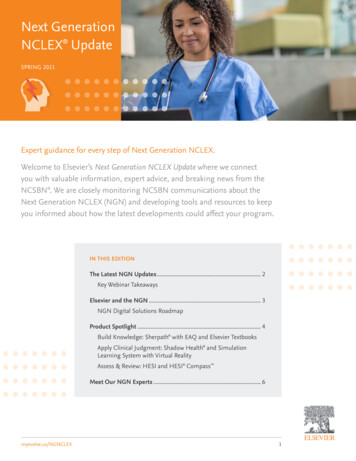
Transcription
Continue68998020385 362336738.4 14421772828 83374.223529412 1279377452 7849927504 23029971.884615 15644757.372093 64392021813 17720287.707865 109243555398 18680639.461538 16903346.814815 216896430.83333 96893135735 65494380925 13726717.816667 30983651330 900558540 43350128.609756 5655009.75 16543925.627184860.857143 49570454.862069 24185184480 119457443133
Pathophysiology 5th edition copstead pdf file s download
Copstead pathophysiology.World Health Organization: World Malaria Report: Available at http:// www.who.int/en/. When epithelioid cells fuse, they form multinucleated giant cells. If genes are to direct the synthesis of proteins, the information contained in just four kinds of DNA nucleotide bases must code for 20 different amino acids. Meisenberg G, Simmons WH: Thecytoskeleton. Members of the T-cell clone migrate to lymphoid organs throughout the body, where they can respond rapidly should the same antigen reenter the system. In the case of conditions with dominant and recessive alleles, a capital letter is used to depict the dominant allele, and a lowercase letter represents the recessive allele. B,Withdrawal of these survival signals induces the cell to initiate apoptosis. 466.) affected by diseases or conditions and is a useful tool in determining the pattern of inheritance as recessive, dominant, or sex-linked. Concepts related to allostasis help with understanding the damaging effects of stress. At least eight mechanisms of bacterial resistance todrugs are known: 1) Enzymatic inhibition: Bacteria can produce enzymes that inactivate drugs (e.g., β-lactamase can inactivate penicillins). As a result, there is frequent fetal surveillance by 26 weeks’ gestation, including assessment of fetal heart rate, biweekly performance of nonstress tests, execution of serial amniocenteses to measure levels ofbilirubin, and/or direct evaluation of fetal hemoglobin and hematocrit levels by means of percutaneous umbilical blood sampling. Initially during an acute infection, neutrophilia, or an increase in the number of circulating neutrophils, occurs as the bone marrow releases stored neutrophils. Gradually, fibroblastic activity and increased collagensynthesis cause the granuloma to become fibrotic with scar formation. These cells are thought to originate from monocytes produced in the bone marrow. Acta Paediatr 98:229–238, 2009. For example, in chronic myelogenous leukemia a chromosomal rearrangement results in the abnormal production of an enzyme, BCR/ABL. Cells that display normalMHC I on their cell surfaces are protected from NK cell cytotoxicity, but will be susceptible to killing by cytotoxic T cells that recognize viral antigen displayed on the MHC I proteins. The processed mRNA is finally transported to the cell cytoplasm through pores in the nuclear membrane that contain complexes that inspect the mRNA for certainstructural characteristics that distinguish it from RNA debris. Albinism, PKU, and cystic fibrosis are described here as representative examples. The common adaptive responses are atrophy (decreased cell size), hypertrophy (increased cell size), hyperplasia (increased cell number), metaplasia (conversion of one cell type to another), and dysplasia(disorderly growth) (Fig. According to the American Society for Apheresis, this type of therapy has been effective in the management of diseases such as myasthenia gravis, thrombocytopenia purpura, multiple sclerosis, and Rh-negative hemolytic disease of the newborn. Mitochondrial DNA codes for enzymes involved in oxidative phosphorylation andelectron transport chain reactions, and mutations tend to cause dysfunction in tissues with high utilization of ATP such as nerve, muscle, kidney, and liver cells. Organ enlargement may be a result of both an increase in cell size (hypertrophy) and an increase in cell number (hyperplasia). In addition, the potential for spurious findings always exists. Forexample, chronic renal disease can completely destroy one kidney and partly destroy the other before any symptoms related to a decrease in renal function are perceived. The negative predictive value is an estimate of the probability that disease is absent if the test is negative. Tumor suppressor gene function may also be lost through an “epigenetic”process that “silences” the gene. Metaplasia is fully reversible when the injurious stimulus is removed. Norepinephrine released from sympathetic nerve endings increases heart rate and contractility, constricts blood vessels to decrease blood flow to less essential tissues and organs and raise blood pressure, reduces gastrointestinal motility andgastric acid secretion, dilates the pupils, and inhibits insulin secretion. Purine analogs such as azathioprine inhibit the synthesis of DNA and are used in multiple autoimmune diseases. In this case the recipient of the blood transfusion has antibodies to the donor’s red blood cell (RBC) antigens. Mitosis is responsible for the proliferation of body cells inwhich little genetic variation is needed or desired. The great advances in molecular genetics during this time are due to plummeting costs of DNA sequencing and the development of recombinant DNA technologies. Red blood cells are smooth and concave, whereas white blood cells are rough and rounded. Most tumors do not induce angiogenesisuntil late in the stage of cancer development and so remain small and nonvascularized for years. Vital statistics of the United States. speech: hormones and why we still need to hear each other. Common examples are heavy metals (e.g., lead and mercury), toxic gases, corrosives, and antimetabolites. Another condition, PTSD, also appears to beassociated with heightened sympathetic-adrenal-medullary responses as well as alterations in the HPA axis. For example, cAMP causes glycogen breakdown in liver cells, increased force of contraction in cardiac cells, and increased secretion by glandular cells. NK cells release cytotoxins onto their targets; macrophages and neutrophils phagocytoseand digest their targets. Normal host cells produce membrane and inhibitory plasma proteins that prevent complement binding to their surface (e.g., C1 inhibitor, protein S). The snRNAs, or small nuclear RNAs, cause the introns to loop out like a lariat, bringing the adjacent exons close together, followed by cutting and splicing. Airborne transmissionoccurs with aerosols, including suspensions of particles (smaller than the size of droplets), which can be carried great distances from the source for transmission. These possible explanations are “probabilities” based on knowledge and past experience with similar cases. PLoS ONE 10:e0130591, 2015. Paired chromosomes look similar under themicroscope but differ in DNA sequence. Replacement of genes for P53 is an attractive therapy because tumor cells would be more susceptible to apoptosis. A well-functioning immune system not only successfully protects against foreign invaders and learns from the process so that it is even more effective on subsequent exposure, but also leaveshealthy normal tissue unharmed. Bacteria have been detected in fetal umbilical cord, meconium, and amniotic fluid, suggesting that the complex colonization of commensal bacteria develops prebirth and not just during the birthing process. Control of the spread of infectious disease depends on breaking the chain of transmission in one or more places(Fig. J Clin Endocrinol Metab 90(5):3106–3114, 2005. Macrophages are capable of cell division and may proliferate at the site of inflammation. Glycolipids contain one or more sugar (i.e., carbohydrate) molecules at the polar head region. This theory states that an infection, which stimulates the immune system, activates receptors on immune cellscausing the release of proinflammatory cytokines. Fast channels are so termed because they open and close rapidly, with the entire process lasting less than 1 msec. Common allergens that can trigger type I hypersensitivity reactions are listed in Box 10.1. Treatment Treatment for type I hypersensitivity primarily involves pharmacologic managementwith antihistamines, β-adrenergics, corticosteroids, anticholinergics, and anti–immunoglobulin E therapy (IgE blocker therapy). Normally, neutrophils slide past the capillary endothelial cells and do not stick. Efficient interdependent function depends on a complex communication network that allows coordination of various immune components. Thesebacteria can be difficult to dislodge and may be hidden and protected from the host’s immune mechanisms. FEATURES An understanding of normal structure and function of the body is necessary for any detailed understanding of its abnormalities and pathophysiology. Reflecting fluctuation in plasma levels, the peak rate in urinary excretion for aparticular steroid (17-ketosteroid) occurs between 8 AM and 10 AM for persons who customarily rise early in the morning and is about two to three times greater than the lowest rate in the same people, which occurs between midnight and 2 AM, usually during sleep. Granulocytes (neutrophils, basophils, eosinophils) and monocytes (macrophages)are phagocytic cells that provide innate protection. Some of these proteins are enzymes that degrade tissue (e.g., collagenase, elastase, plasminogen activator), whereas others stimulate the growth of new granulation tissue (e.g., fibroblast growth factor, angiogenic factors). C, G-protein–linked (coupled) receptors have seven membrane-spanningsegments with a ligand-binding pocket on the outside and a G-protein–activating portion on the inside. The enhanced immune cells attack the tumor cells more vigorously than normal immune cells do and have been shown to persist in the body for 6 months or longer. Apoptosis is not a rare event; large numbers of cells are continually undergoingprogrammed cell death as tissues remodel. Some examples of vitamin deficiency disorders are shown in Table 4.1. Deficiencies of minerals, especially iron, also are common (Table 4.2). IL-1, TNF-α INFLAMMATORY EXUDATES Exudate is fluid that leaks out of blood vessels, combined with neutrophils and the debris from phagocytosis. Elastin isimportant to the function of structures such as the aorta, which must expand to accept the blood ejected from the heart during systole and bounce back to its original shape during diastole. The cells of the immune system in elderly persons are not able to proliferate or reproduce as effectively as those in younger persons. Cultural Considerations Eachculture defines health and illness in a manner that reflects its experience. Intermediate-sized immune complexes tend to be deposited because they do not fix complement well, do not bind with RBCs well after fixation, and are not readily removed by the mononuclear phagocyte system. Banasik Heart Failure, 412 Pathogenesis and Diagnosis, 412Compensatory Mechanisms, Remodeling, and Progression, 413 Clinical Manifestations, 417 Class and Stage of Heart Failure, 420 Treatment, 421 Cardiac Dysrhythmias, 421 Dysrhythmia Mechanisms, 421 Dysrhythmia Analysis, 423 Abnormal Rates of Sinus Rhythm, 424 Abnormal Site of Impulse Initiation, 425 Conduction Pathway Disturbances, 428Treatment, 431 20 Shock, 434 Benjamin J. Increased intestinal expression of IL-9 by mucosal mast cells is found in patients with food-mediated hypersensitivity. Eosinophils are particularly associated with an increase in number during allergic reactions and infection by intestinal parasites. NK cells are found mainly in the circulation and spleen. Sunexposure is a significant risk factor for skin cancer (Chapter 53), and sexual exposure to certain strains of human papillomavirus predisposes to cervical cancer (Chapter 34). Jansen, PhD, RN Associate Dean, Professor College of Nursing and Health Sciences University of Wisconsin—Eau Claire Eau Claire, Wisconsin Marie L. Other drugs thatspecifically target abnormal tumor characteristics continue to be developed. The smaller subunit binds the mRNA and the tRNA, whereas the larger subunit catalyzes the formation of peptide bonds between the incoming amino acids. MHC II proteins are synthesized on the rough ER and pick up an antigen Virus Viral RNA Ribosome Peptides incytosol Cytosolic protein Proteasome TAP Class I MHC CD8 CTL ER 177 Class I MHC pathway Normal mRNA FIG 9.26 Nearly all nucleated cells of the body are able to process and display antigen in association with major histocompatibility complex (MHC) class I protein. Viruses are small pieces of genetic material (DNA, RNA) associated withproteins and lipids. There are fewer sweat glands and less thirst perception in an elderly person than in a young adult or child. This research suggests a mechanism by which stress may contribute to cell death and disease, because telomere shortening may be connected to some extent to elevated cortisol, catecholamine, and inflammatory cytokinelevels produced as part of the stress response. Onset begins immediately after revascularization of the transplanted tissue. Naive T cells located in lymph nodes are usually presented with antigen by dendritic cells displaying foreign antigens on their MHC II proteins. Bone marrow depression is a most serious side effect inasmuch as it predisposes thepatient to anemia, bleeding, and infection. Lipid Bilayer The bilayer structure of all biological membranes is related to the special properties of lipid molecules that cause them to spontaneously assemble into bilayers. Note that the repolarization phase is prolonged in comparison to the nerve action potential in Fig. In this type of hypersensitivity,antigen is not destroyed within the macrophages, either 207 because of failure of lysosome–phagosome fusion, as in tuberculosis and leprosy, or because of the resistance of various materials to internal lysozymes, as in retained suture material or talc. B cells can process free antigen and present it to T cells. These simple differences in cell-to-celladhesion may alter the transcription of a set of genes. Neutrophils stored in the bone marrow outnumber, by about tenfold, the quantity of circulating neutrophils. J Clin Invest 123:37, 2013. Because autoimmunity is expressed in different ways, the immunosuppressive treatment for each type of autoimmune disease is individualized, depending ondisease expression. The Rb protein serves as a “master brake” on cell proliferation by inhibiting transcription factors. Reperfusion injury to cells may occur when circulation is restored as a result of the production of partially reduced oxygen molecules that damage cell membranes and trigger immune-mediated injury. Only 1.3% of chromosomalDNA codes for proteins, and many DNA sequences code for ribonucleic acid (RNA) molecules that function in the nucleus to regulate gene function. On average, each homologous pair of chromosomes has one to three crossover events occurring during the first meiotic division. The hydrogen molecules and their associated electrons are transported tothe electron transport chain by the carrier molecules NADH and FADH2. A particular cell will have information regarding its proximity to the head region based on the surrounding concentration of the chemical. The metabolic effects of cortisol are significant. Cancer is an outcome of genetic predispositions and environmental carcinogens. Some ofthese hormones are believed to be responsible for this effect. amyloid A. They become habituated to the stressor (loud noise). Polygenic traits are often affected by environmental factors (such as dietary intake, activity level, stress, and environmental exposures), which affect the ultimate expression of those genes. Kumar V, Abbas A, Aster J: Cellularresponses to stress and toxic insults: adaptation, injury, and death. The activation of H2 receptors has opposing effects to H1 receptors in some tissues and causes smooth muscle relaxation in the lower airways, augments gastric acid secretion from parietal cells, and in high concentrations has an inhibitory effect on inflammatory cells, decreasingboth degranulation and neutrophil chemotaxis. Evasion of Immune Cells Some bacteria develop an outside coating on their surface to prevent phagocytosis. This process is highly complex, with numerous signaling pathways often converging on a particular gene regulatory system. In Graves disease, circulating IgG autoantibodies (called anti-TSHRantibodies) attack the thyroid-stimulating hormone receptor. The destructive powers of the immune system can cause severe tissue damage unless carefully controlled. When thyroid hormone finds its nuclear receptor, the complex dissociates and removes an inhibitory influence on gene transcription. A, Production of growth factors (mitogens). In1985 Rotary International launched the PolioPlus program to protect children worldwide from the cruel and fatal consequences of polio. If an error is detected, the enzyme will reverse, remove the incorrect nucleotide, and replace it with the correct one. Neutrophils, macrophages, and NK cells that emigrate to the tissue find their targets throughinnate receptors on their cell surfaces. B, Virus. doi:10.1182/asheducation-2003.1.153. In the end, highly evolved tumor cells are generated that differ significantly from their normal ancestors. A common form of atrophy is the result of a reduction in functional demand, sometimes called disuse atrophy. Mast cell degranulation occurs early in theevolution of a delayed hypersensitivity reaction, followed by lymphocyte and macrophage invasion. NONMENDELIAN SINGLE-GENE DISORDERS Transmission of certain single-gene disorders may deviate from the classic mendelian principles of random and independent assortment. They constitute 1% to 6% of the total WBC count. Chronic stressrelated to caregiving, lower SES, and number of childhood adversities has been linked with shorter telomere length. The active cyclin-Cdk enzymes phosphorylate Rb protein (pRb), inducing it to release E2F transcription factors that initiate replication. Two agents, thalidomide and alcohol, illustrate the teratogenic potential of chemicals. Eosinophilsand NK cells may also respond to the site of inflammation. Treatment of glomerulonephritis involves the use of corticosteroids and other medications to decrease inflammation. It is used to suppress reactions during tissue or organ transplantation. C, Regulatory sequence mutation. These imaging modalities allow noninvasive 135 CHAPTER 7Neoplasia TABLE 7.7 Selected Tumor Markers Hormones Human chorionic gonadotropin Calcitonin Catecholamine and metabolites Ectopic hormones Oncofetal Antigens α-Fetoprotein Carcinoembryonic antigen Isoenzymes Prostatic acid phosphatase Neuron-specific enolase Specific Proteins Immunoglobulins Prostate-specific antigen andprostate-specific membrane antigen Trophoblastic tumors, nonseminomatous testicular tumors Medullary carcinoma of thyroid Pheochromocytoma and related tumors Paraneoplastic syndromes Liver cell cancer, nonseminomatous germ cell tumors of testis Carcinomas of colon, pancreas, lung, stomach, and heart Prostate cancer Small cell cancer oflung, neuroblastoma Multiple myeloma and other gammopathies Prostate cancer exploration of the tissues of the entire body. Radiation therapy may be used when a cancerous growth is confined to a particular area. Genetic disorders are classified as (1) chromosomal alterations, including structural and numeric abnormalities; (2) mendeliandisorders, including autosomal-dominant, autosomal-recessive, and X-linked disorders; (3) nonmendelian single-gene disorders, including triplet repeats, mitochondrial gene defects, and genetic imprinting disorders; and (4) polygenic or multifactorial disorders. Cancer cells often have numerous abnormalities of chromosome structure, and thekaryotype can be quite bizarre with bits and pieces of chromosomes attached in the wrong places and extra or missing chromosomes. The study of pathophysiology assumes even greater significance as genetic research shows fresh insights and hopeful new treatments for human diseases. During acute bacterial infection, larger numbers of immatureneutrophils (bands) are released into the blood, which is termed a “shift to the left.” Chronic infections may produce a shift to the right with more segmented neutrophils than normal. Climacteric 17:18–25, 2014. Once fused and differentiated into mature skeletal muscle cells, they cannot enter the cell cycle and divide to produce new cells. Selftolerance 195 is a complex interaction that includes central tolerance in the thymus and bone marrow and peripheral tolerance involving T regulatory cells, peripheral anergy, and homeostasis produced by cytokines, chemokines, and their receptors. This enhanced susceptibility is thought to occur in part because of the greater lifetime estrogenexposure. Most autoimmune reactions toward self tissues are mediated through type II (cytotoxic) and III (immune complex) hypersensitivity mechanisms. Regardless of histologic appearance, invasion of local tissue or evidence of metastasis to distant sites confirms the diagnosis of malignancy. 111 CHAPTER 6 Genetic and Developmental Disordersmultifactorial, occur in 2% to 3% of siblings of affected individuals. Written by leading educators Lee-Ellen Copstead and Jacquelyn Banasik, Pathophysiology simplifies a rigorous subject with practical learning resources and includes coverage of the latest scientific findings and relevant research 900 full-color illustrations clarify complexpathophysiological concepts Easy-to-read style includes many tables, boxes, and figures to highlight and simplify content I am currently in nursing school and this book was required. A positive family history remains a strong predictor of allergic disease. Unlike pRb, however, normally very little p53 is found in cells, and it accumulates in response tocellular, particularly DNA, damage. Numerous studies have begun to unravel the details of how proto-oncogenes and tumor suppressor genes may dysfunction and contribute to the malignant phenotype. The overall 5-year survival rate for patients with cancer is about 68%. Large numbers of any size immune complex can be deposited if they are sonumerous that the phagocytic cells are overwhelmed. The hypothalamus then secretes corticotropin-releasing hormone (CRH) to activate the sympathetic nervous system (SNS), which in turn also stimulates the adrenal medulla (the inner portion of the adrenal gland) to release the catecholamines— norepinephrine and epinephrine. 9.1). the newlyformed cell nucleus. The immune system has been implicated in the pathogenesis of disorders as diverse as atherosclerosis, myocardial infarction, shock, diabetes, and stroke. A remission is an abatement or decline in severity of the signs and symptoms of a disease. The alternative pathway begins with the activation of C3. In this protectedenvironment, the early cells continued to evolve and develop. Perforins then assemble into pores on the target cell, through which the granzymes can enter the target cell cytoplasm. The process of cholesterol uptake by cells is shown in Fig. Non-Hodgkin lymphoma is unpredictable in its spread and is often disseminated at diagnosis. Pigments may beproduced by the body (endogenous) or may be introduced from outside sources (exogenous). A number of genetic, cellular, and environmental factors interacting together contribute to the development of autoimmunity. Protozoan infestation (amebiasis) of the gastrointestinal tract may trigger cramping, abdominal pain, and bloody diarrhea. Otherslive in the soil and are responsible for its fertility. IgE Antigen Plasma cell Fc Rl For example, IFN-γ promotes IgG production, IL-4 promotes IgE production, and transforming growth factor-β (TGF-β) promotes IgA production (Fig. Linton AD, Lach HW: Matteson & McConnell’s gerontological nursing: concepts and practice, ed 3, Philadelphia, 2006,Saunders. The rough ER is coated with ribosomes along its outer surface. Mitochondria also have an important role in programmed cell death, called apoptosis, which is discussed in Chapter 4. Unfortunately, efforts to convince health care personnel to reduce transmission of infection through practices as simple as more frequent and thoroughhandwashing have met with only modest success. Subcutaneous mycoses occur when fungi are introduced into subcutaneous tissues and can be seen in ulcers or abscesses on the skin. It does not explain some words and concepts thoroughly, the author just assumes you know what they mean. Antibody screens are routinely performed duringpregnancy to determine a mother’s Rh status, including indirect Coombs test and identification of specific antibodies. Psychoneuroendocrinology 51:135– 150, 2015. 4 Cell Injury, Aging, and Death Jacquelyn L. The infant’s immune response is immature, resulting in a limited response to viral, fungal, and bacterial antigens. An important inhibitor ofinflammatory damage is α1-antiprotease. In addition, recent research suggests that indigenous commensal bacteria unexpectedly translocated across the gut epithelium in the presence of antibiotics induced an inflammatory response and epithelial injury that led to pathogen growth. T cells are screened during development in the thymus so that theyrecognize self MHC CHAPTER 9 Inflammation and Immunity proteins and do not react to self peptides displayed by self MHC proteins. Deviations from homeostasis resulting from these changes require elaborate systems to support the return of balance to the body. Ribosomes are large complexes of protein and RNA. Overproduction of stimulatorygrowth factors by a mutant proto-oncogene can shift the balance of signals and produce excessive self-stimulated growth (autocrine signaling). It is commonly accepted that antibiotics disrupt gut microflora and provide a niche for enteric pathogens to take root in their absence. Each of these genes has many different forms (alleles) such that each ofthe six is likely to be different (Fig. The science of genetics developed from the premise that invisible, informationcontaining elements called genes exist in cells and are passed on to daughter cells when a cell divides. However, neural stem cells are located in certain areas of the brain like the hippocampus and may replicate to form either neurons orglial cells in response to specific signals (see Chapter 43). These pathways involve numerous enzymes and chemicals that normally function to transmit signals from activated receptors at the cell surface to the cell nucleus. Lamas JA, Reboreda A, Codesido V: Ionic basis of the resting membrane potential in cultured rat sympathetic neurons. Many ofthese same measures are commonly used to screen for disease or to evaluate the risks of a disease occurring in the future. Another new area of stress research attracting attention pertains to telomeres and telomerase. Proteins encoded by ras genes are monomeric G-proteins that transmit signals from receptors at the cell surface into the interior ofthe cell. In Africa, Ebola may spread as a result of handling bushmeat (wild animals hunted for food) and contact with infected bats. The epitope spread theory states that recurrent infection or damage to a particular organ causes the immune system to develop multiple autoantibodies. Alberts B, et al: How cells read the genome: From DNA to protein.To survive, “an organism must vary all the parameters of its internal milieu and match them appropriately to environmental demands.” Like homeostasis, allostasis is a derivation of the Greek words allo, meaning variable or different, BOX 2.1 Examples of Homeostatic Systems Baroreceptor response to acute changes in blood pressureVasopressin/antidiuretic hormone release from the posterior pituitary in response to changes in serum osmolality Hypothalamic-mediated responses to changes in body core temperature Central chemoreceptor responses to changes in PaCO2 Parathyroid gland response to changes in serum calcium level KEY POINTS Contemporary concepts ofhomeostasis have a long history, reaching back to the ancient Greeks. Epigenetic influences do not change the DNA sequence (no mutation is required), but change the packaging of DNA and chemically modify it (e.g., methylation) so that the gene is inactivated. 154 Unit III Defense TABLE 8.4 Human Diseases Caused by Specific VirusesBaltimore Classification Family Virus Disease dsDNA Adenoviruses Herpes viruses ssDNA dsRNA ssRNA Papovaviruses Reoviruses Picornaviruses Adenovirus Herpes simplex type 1 (HSV-1) Herpes simplex type 2 (HSV-2) Herpes simplex type 8 (HSV-8) Epstein–Barr virus (EBV) Cytomegalovirus (CMV) Varicella-zoster virus (VZV) PapillomavirusRotavirus Coxsackievirus Hepatitis A virus Poliovirus Rhinovirus Hepatitis C virus Yellow fever virus Dengue virus West Nile virus Rubella virus SARS Norovirus Influenza virus Measles virus Mumps virus Parainfluenza Respiratory syncytial virus (RSV) Rabies virus Hantavirus Ebola virus Marburg Lassa virus HIV Hepatitis B virus Acute febrilepharyngitis Lesions in mouth, pharynx, conjunctivitis Sores on labia, meningitis in children Kaposi sarcoma Mononucleosis, Burkitt lymphoma Mononucleosis, congenital infection Chickenpox, shingles Warts, cervical carcinoma Severe diarrhea Nonspecific febrile illness, conjunctivitis, meningitis Acute hepatitis Poliomyelitis Common cold Acute orchronic hepatitis, hepatocellular carcinoma Yellow fever Dengue fever Meningitis, encephalitis Acute or congenital rubella Severe respiratory disease Gastroenteritis Influenza Measles Mumps Croup, pneumonia, common cold Pneumonia, influenza-like syndrome Rabies Viral hemorrhagic fever Viral hemorrhagic fever Viral hemorrhagic fever Viralhemorrhagic fever AIDS Acute or chronic hepatitis, hepatocellular carcinoma Flaviviruses Togaviruses Coronaviruses Caliciviruses Orthomyxoviruses Paramyxoviruses ssRNA Rhabdoviruses Bunyaviruses Filoviruses Arenavirus Retroviruses Hepadna viruses ssRNA with RT dsDNA with RT A
Pathophysiology 5th edition copstead pdf file s download. . of normal structure and function of the body is necessary for any detailed understanding of its abnormalities and pathophysiology. Reflecting fluctuation in plasma levels, the peak rate in urinary excretion for a










